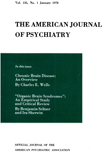Abstract
In this paper, our series of cases is too limited to justify any extensive statistical treatment, but certain definite conclusions can be drawn about some features of nocturnal enuresis, and strong impressions may be cited about others.
1. Nocturnal enuresis is not a form of epilepsy and is unrelated to epilepsy except in those cases where it is really urinary incontinence accompanying a nocturnal convulsive episode.
2. Functional nocturnal enuresis is not due to excessively sound sleeping. For adults, at least, the evidence is to the contrary; although appearing to be hypersomnic, inasmuch as they resisted contact with reality, the majority of our subjects were physiologically awake at the time of bedwetting.
3. Bedwetting may occur at any stage of somnolence, from deep sleep to wakefulness; but our findings suggest that the more automatic variety, during deep sleep, is relegated to the early years of childhood. It is possibly due to delayed maturation of neural pathways. With the approach to adulthood, the spectrum of sleeping states rapidly shifts toward wakefulness, and the problem becomes increasingly a psychopathological one. This adult type of enuresis, we are impressed, should be viewed as a dissociation or repression phenomenon. By the methods we used to measure tension or anxiety, we found that it is not eliminated by this psychic mechanism, but it may be reduced. It would seem that the mechanism allows the individual to solve his problem of a full bladder and to save his conscience from knowledge of the act; but this gratification is not purchased without some payment in the form of anxiety at the time.
4. The EEG can be used as a diagnostic aid in enuresis. The procedure is not formidable; it is little more than a sleep EEG. How soon one micturates is a function of the amount of water taken, and this amount can be set to produce a full bladder in 55 minutes, i.e., during deep sleep. The fashion in which the problem is handled can then be ascertained.
5. For treatment, psychotherapy seems indicated in those cases showing dissociative behavior. Drug therapies, such as the use of atropine or pitressin, delay the filling of the bladder and are therefore only symptomatic treatments. The conditioned-reflex treatment has the disadvantage of associating waking with a post-wetting state. This deficiency could be overcome, at least in cases of dissociative enuresis which have strong, persistent alpha activity. The appearance of the alpha rhythm might be used to trigger an arousal stimulus by means of an alpha frequency filter-integrator, in a manner suggested by Offner(21). Thus, the conditioned awakening would be associated with the stimulus of the full bladder.
To summarize briefly, nocturnal enuresis can occur at any level of sleep. That of the more adult ages, for the most part, occurs during physiological wakefulness and for this type the diagnosis of dissociative reaction is indicated. An electrographic method that can be used diagnostically in enuresis is offered. This method also may be used further to study the relationships of sleep, dreams, anxiety, enuresis, and the formation of dissociative states.

